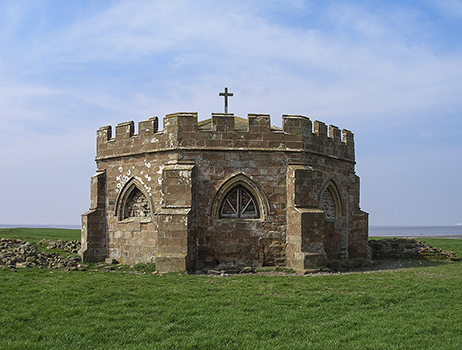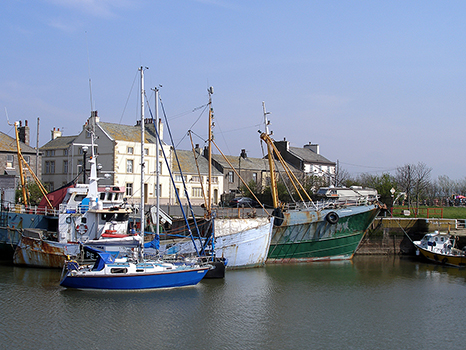 |
 |
|
| Chapter House at Cockersand Abbey looking westwards | Glasson Docks |
The remains of Cockersand Abbey are covered here not so much because they are a hidden gem but because Lancashire had relatively few abbeys. The remains are indeed remote, on that long stretch of largely unihabited coastline between the estuaries of the Lune and the Wyre. However all that remains now is the Chapter House. To reach the site it is best to park at Glasson Dock on the south side of the Lune estuary and walk the 2.5 miles along the coastal path.
 |
 |
|
| Chapter House at Cockersand Abbey looking westwards | Glasson Docks |
In 1180 there was a hermitage of Hugh Garth on the site. He founded a hospital for the sick and lepers. In 1190 it became the site of a priory of the Premonstratensian Canons, who took their name from the French Abbey of Premontré. In due course it became wealthy enough to become an abbey, owning property across Lancashire and Cumbria. In the 12th century the land was undrained marshland and the buildings were on a low island of clay. From this situation the abbey gained its name of St. Maria de Maisen, or St. Mary of the Marsh. The ground plan was similar to that of many other abbeys with a cruciform church with two transepts but no aisles to the nave. Between the south transept and the nave was the square cloister. Extending from the south transept to the south was a range with the dormitory above and the chapter house projecting on the east side. Domestic building including the refectory surrounded the cloister to the south and west. The Lady Chapel, added in the 14th century was a separate building to the north of the north transept. The abbey was dissolved in 1539 and the land aquired by John Kitchen.
The external part of the Chapter House has survived as it was converted to a burial place by the Dalton family of Thurnham Hall, who acquired the site in the late 16th century. Most of the masonry of the abbey was used in building the seawall that allowed the area to become farmland instead of marsh. Much of the stone was from a local outcrop of Old Red Sandstone but later some much harder grey gritstone was used which weathered better.
Glasson Dock was built in 1787 as a new port for ships too large to reach Lancaster up the River Lune. In 1826 the Dock was connected to the Lancaster Canal by a new waterway running from Glasson to Galgate. Lancaster had trade with the Baltic and the West Indies, participating in the Slave Trade. The Dock was also a shipbuilding centre. Nicholsons and Sons yard built the schooner 'Ryelands' here in 1887. It became well known as the 'Hispaniola' in the film 'Treasure Island' and was used in Morecambe for tourists as the 'Moby Dick' until burnt out in 1970. Glasson has a graving dock for ship repair from 1840 to 1968. The railway reached Glasson in 1883, superseding the canal but passenger services ended in 1930 and freight services in 1964.
The Religious Houses of Lancashire in the Victoria County History, published in 1908
'The Chartulary of Cockersand Abbey', transcribed by W. Farrar, was published in seven parts by the Chetham Society between 1898 and 1909, NS volumes 38, 39, 40, 43, 56, 57 & 64 but do not appear to be accessible online.
Information provided for visitors on noticeboards